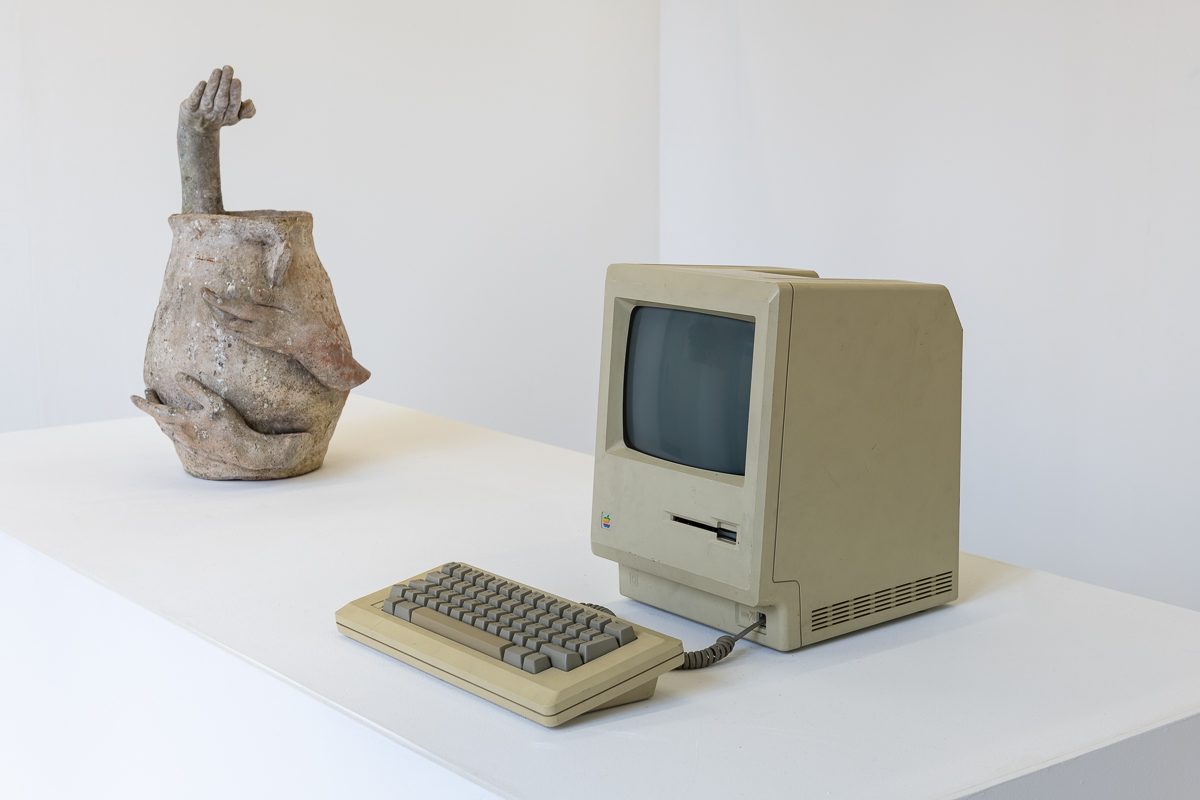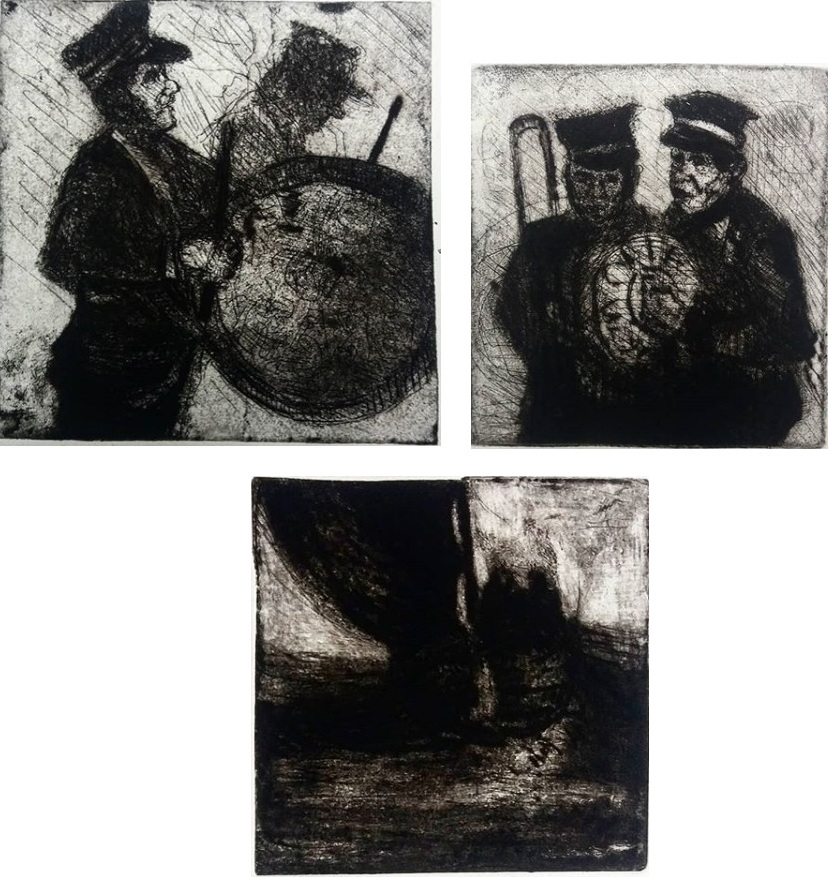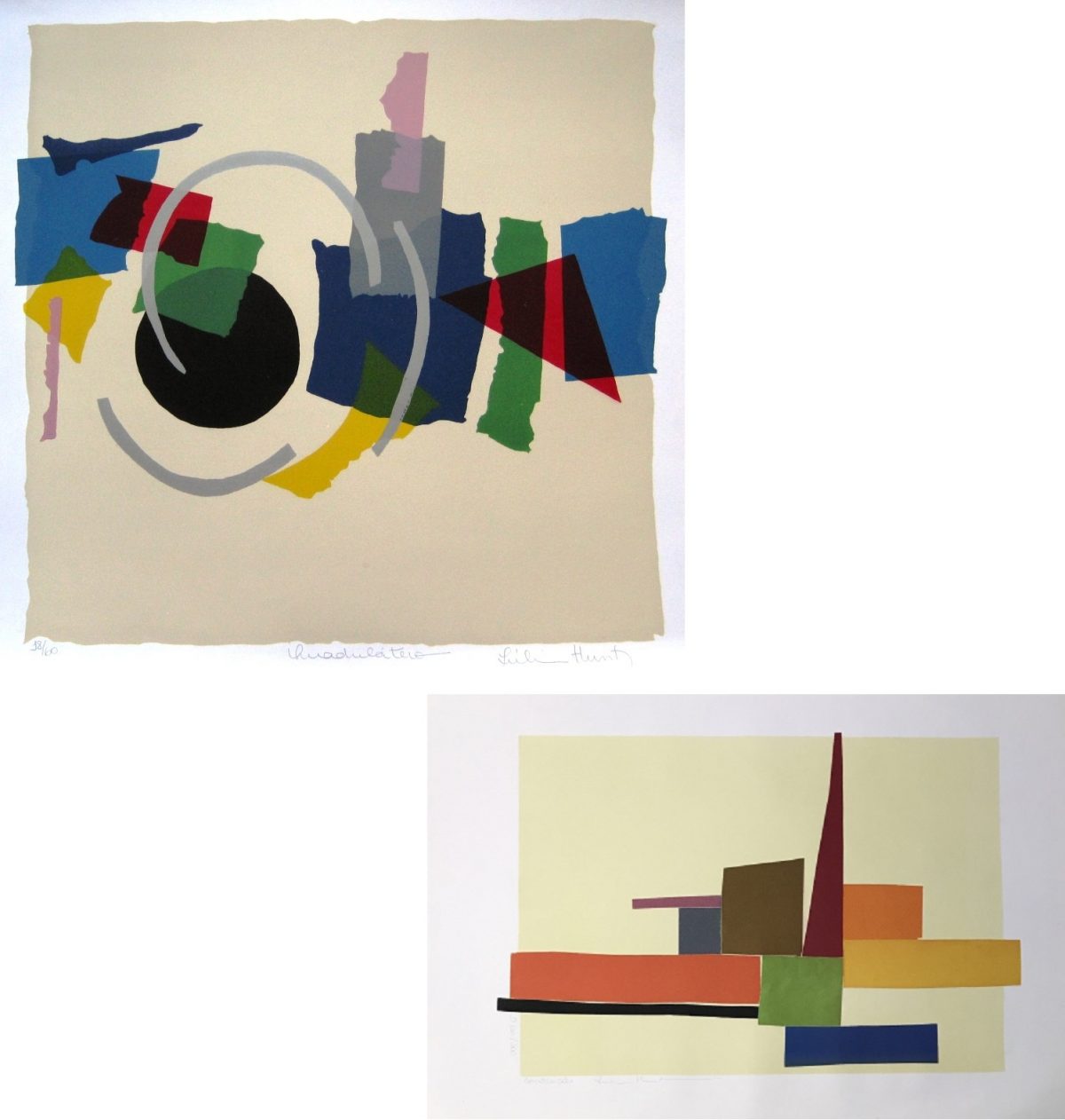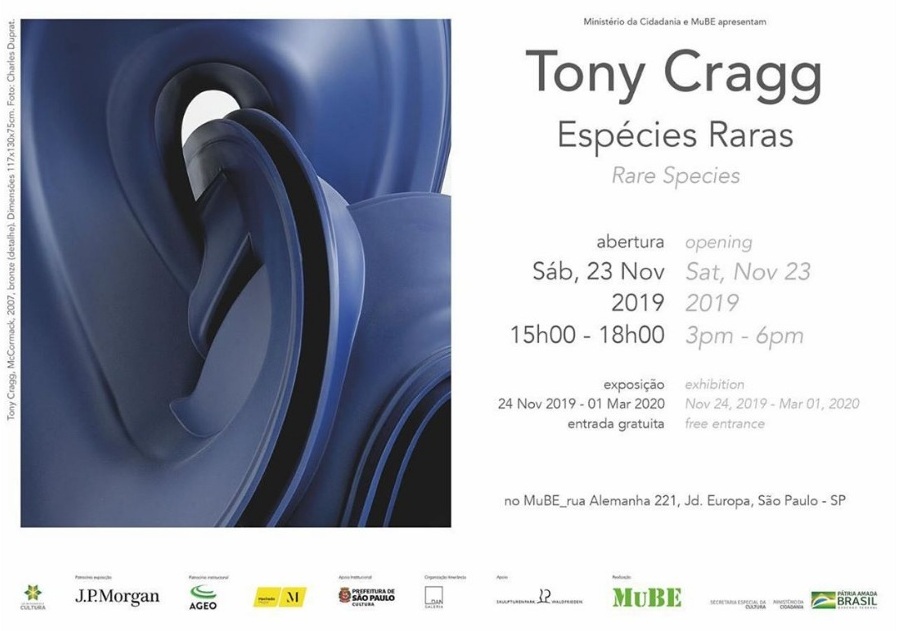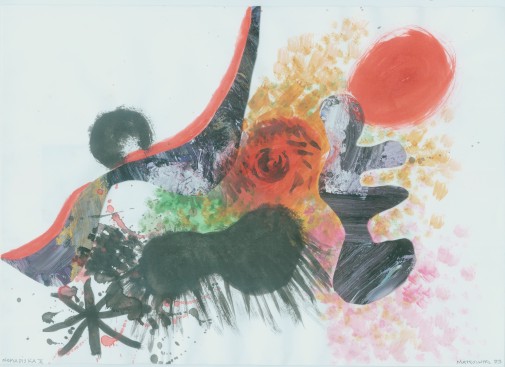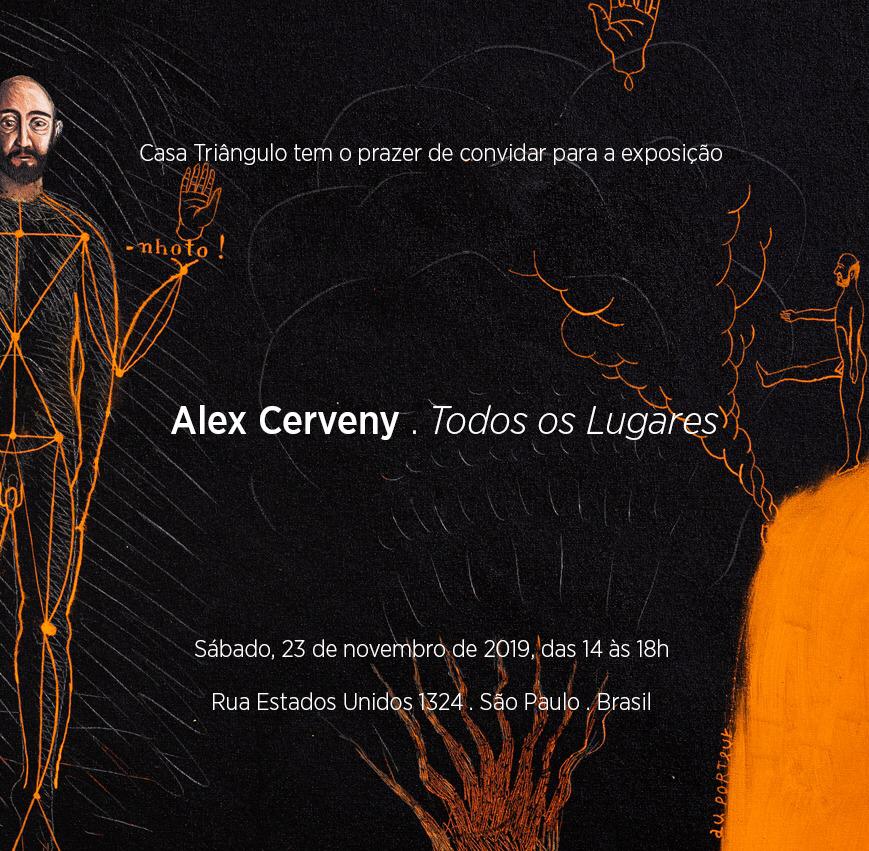Conforme comentou no Facebook Maria Lúcia Campiom Arantes: “Quem precisa de Black Friday????” Vejam mais belas imagens postadas pelo primo Antonio Eduardo Silva (Toninho da Texaco) do Rio Paraná em Epitácio.
Mês: novembro 2019
Exposição da Maria do Carmo
Question Centre presents – Clementine Keith-Roach
Steve Jobs
Press release: The Manual
On its sixth edition, Question Centre is thrilled to present a new work by Clementine Keith-Roach alongside a Macintosh 512K, the second generation of Macintoshes to ever be produced.
There’s an intrinsically perverse timeline on show. The newest object alludes in fact to a pre-historical form1 whereas the oldest one, now obsolete, stands for a fairly new creation in terms of history. They share a similar scale and colour scheme, and are displayed over a long plinth under a same hierarchy of values. They are also equally revolutionary in terms of the new order that they’ve imposed on our daily lives, and it’s astounding how the basic shape of the vessel has hardly changed over the past several centuries. Both vessel and computer carry within a metaphoric value as storage units while alluding to labour and functionality. Yet placed together they become sculptural objects.
Clementine Keith-Roach’s practice essentially blends notions of found objects and manual labour. The artist’s starting point is often Mediterranean storage vessels that have histories of use, revealed both in the aged patina of their surface and in the residue of the commodities they have held. She anthropomorphises their form with casts of her own body. There is a striking smoothness in the resulting objects, as if the hands that make these pieces and the resulting works – the old tale of creature and creator – had always belonged together as one single body. The artifice is reinforced by the choice of colours and treatment of the surface, as all added parts follow the original colour scheme of the vessel, which inevitably spans brown, beige or rusty-ish tones that are natural of clay. The hands’ shapes are always anew, seductive but never vulgar, seemingly partaking in a particular dance or vocabulary that obeys their own terms and whose codes are unknown. They point, invite, suggest and demand, like oracles that are quick to answer questions in whatever biased ways the viewers want to interpret them.
For instance, the work on show presents three hands, one of which, placed on top of the sculpture’s mouth, contains coins; whether that’s an offer or a demand to the viewer is entirely up to interpretation.
The Macintosh was not the first personal computer to ever be commercialised. Nor was it the first such machine to be created by Apple Inc. Its development started in 1979 and ran concurrently to that of Apple Lisa, which had commenced a year prior within the same company but under different teams. Steve Jobs, who alongside Steve Wozniak and Ronald Wayne had founded Apple Inc. in a Palo Alto garage in 1976, was in charge of both designs – that is, until he got kicked out of Lisa’s team. The greatest, revolutionary differentials of the product were its Graphical User Interface (GUI) and a mouse. Two days before the Apple Macintosh – later rebranded Macintosh 128K – was released in the market, the lavish
commercial ad of the machine premiered during Super Bowl, on 22 January. Titled 1984 both after that calendar year and George Orwell’s dystopian novel and directed by Ridley Scott, it featured a hot blond woman setting the minds of inebriated, obedient men free from the chains of the big brother. If in times of exceedingly political correctness the treatment of that female character, aligned with an aesthetic reminiscent of Leni Riefenstahl’s propaganda films, would mean a probable boycott to the product, the computer was generally well-received by the public back then. This is the class of computers that Apple The vessel is arguably the oldest utilitarian object created by humankind 1 continued to invest in over the subsequent years, and the one that’s on market to this day. The impact that particular creation and its offsprings had, and continues to exert, in the realms of fashion, art, vocabulary, interpersonal relationships, and indeed in terms of the way we speak out for relevant causes, cannot be underestimated – the least of all accurately assessed.
Question Centre is a nomadic platform of exhibitions that draws on generational bonds among artists, making use of both conventional and unconventional art spaces. It presents fresh works by a contemporary artist alongside a piece by a practitioner from a previous generation (active or historic), conceived the year the younger one was born. Such a piece may be an artwork or any other item or event that offers an insight into the year of birth of the invited artist. This ‘obstruction’ aims to both contextualise a present day practice within a historical perspective and play with the general obsession of the ‘forever young’ – omnipresent in the artistic environment – thus raising questions concerning generation and context. The platform borrows its title from James Lee Byars’ The World Question Center (1969), exhibited in its first edition (at Supplement Gallery, London, in June 2014), together with works by Alexandre da Cunha. Other editions showcased the work of Marcius Galan in relation to Antonio Dias’ The Illustration of Art: The New York Information System, from 1972 (Pivô, São Paulo, January 2015); a series of paintings by Caragh Thuring alongside a 1972 Thames Television footage featuring maverick snooker player Alex ‘Hurricane’ Higgins (Westminster Waste, London, July 2016); a new commission by Jack Killick in relation to a brooch by Gerard Taylor (StudioRCA Riverlight, London, February/ March 2017) and Alexander Calder’s magnanimous Black Widow (1948) contrasting erotic paintings by Portuguese artist Julião Sarmento. The project is developed by Maria do Carmo M. P. de Pontes.
Clementine Keith-Roach was born in London, United Kingdom, in 1984. She lives and works in Dorset, United Kingdom.
Steve Jobs was born in San Francisco, USA, in 1955. He died in Palo Alto, USA, in 2011.
Works on show
Clementine Keith-Roach
System, 2019
Mediterranean storage vessel, jesmonite, paint, copper coins
56 x 34 x 34 cm
Steve Jobs/ Apple Inc.
Macintosh 512K, 1984
Mixed media
34.5 x 24.4 x 27.7 cm
Acknowledgements
To Kiki Mazzucchelli – always, inevitably. To Question Centre’s board (Alexandre da Cunha, Marcius Galan, Caragh Thuring and Jack Killick), Daniel and Penelope Kupfer, Alexandre Canonico, Toby Matthiesen, Christopher and Rainer Page, Angélica Fajardo, Paul David Price and Audio Gold.
More info
mariapontes@mac.com
contact@kupfer.co
Não é por acaso, Eudócio!
Manuel Eudócio – Manuel Eudócio Rodrigues, conhecido como Mestre Eudócio, nasceu em 1931, em Pernambuco, na comunidade de Alto do Moura, próxima à cidade de Caruaru. Faleceu em Caruaru em 13 de fevereiro de 2016. Esta localidade é famosa pela “escola” de Mestre Vitalino (1909-1963), ícone da arte de retratar no barro tipos, usos e costumes do cotidiano do povo nordestino. A influência de Vitalino no trabalho de Eudócio é marcante, bem como a de seu cunhado Zé Caboclo – José Antonio da Silva (1921-1973), conhecido como “o primeiro discípulo de Vitalino”. O artista criou dezenas de tipos que são hoje marca registrada de seu consagrado trabalho, tais como Lampião e Maria Bonita, Noivos a Cavalo, Vaca na Ordenha, Casamentos, Velha indo para a Missa e tantos outros. As peças de Manuel Eudócio são queimadas em rústico forno a lenha, baixa temperatura, sem o uso de esmalte. Numa segunda etapa são pintadas em geral com cores fortes e brilhantes. Seus trabalhos constam do acervo de importantes museus e coleções particulares como o Museu do Barro em Caruaru-PE, Museu do Homem do Nordeste em Recife-PE, Museu Casa do Pontal no Rio de Janeiro-RJ, Museu do Folclore Edison Carneiro no Rio de Janeiro-RJ, Museu Castro Maia (Chácara do Céu) no Rio de Janeiro-RJ. Até hoje, aos 74 anos, o artista continua em plena atividade. Em agosto de 2005 foi homenageado através de sua primeira exposição individual “Manuel Eudócio-Patrimônio Vivo” na Sala do Artista Popular do Museu do Folclore no Rio de Janeiro-RJ. Segundo Moacir dos Anjos, diretor do Museu de Arte Moderna Aluísio Magalhães, no Recife, “Eudócio é o mais original e instigante entre os artistas brasileiros vivos que trabalham com o barro”.
artepopular #artepopularbrasileira #manueleudocio #sobrado7 #lurdinhavasconcelos #anaveloso #brunoalbertim #shoppingriomar #2abaddesign #altodomoura #eudessantana #giselaabad
Vídeo de divulgação do artista
Rodrigo Pecci: Gravuras em metal
Rodrigo Pecci nasceu em Porto Alegre em 1976. Atualmente mora e trabalha em São Paulo, capital. Por dez anos atuou como técnico, impressor e professor de gravura em metal no Museu do Trabalho, em Porto Alegre, trabalhando com artistas como Maria Tomazelli, Eduardo Haesbaert e Wilson Cavalcanti. Participou de diversas exposições e salões no Rio Grande do Sul, entre elas “Olhar Intimista”, da exposição “Diálogos” em 2004, que ocorreu simultaneamente em Porto Alegre, na Casa de Cultura Mário Quintana, e em Quilicura, Chile. Foi vencedor do Prêmio Açorianos/ Artes Plásticas – Destaque em Gravuras, no ano de 2008. Ilustrou dois livros do escritor Altair Martins, “A Parede no Escuro” (2009) e “Enquanto Água” (2011). Lançou, em 2010, um livro de desenhos da coleção Gafanhoto. Em 2012 participou como artista convidado do acervo da Galeria Logo em São Paulo com a exposição “Lista”. Rodrigo trabalhou no Instituto Tomie Ohtake e no Centro Cultural Carlos Oswald, como professor de gravura. Foi um dos artistas da coletiva “As Margens do Centro”, no Estúdio Lâmina, onde também teve sua exposição individual “Desajustados … Nômades… Andarilhos…” em 2011, também em São Paulo. Em 2015, na Matilha Cultural em São Paulo, teve sua exposição individual intitulada “Fila da Sopa”. Em 2016 se muda para New Orleans, Estados Unidos, para uma temporada de um ano onde participa de uma residência no Joan Mitchell Center, realiza a exposição individual “Distant Gaze” na May Gallery e participa de 3 exposições coletivas: “Synopsis of an Urban Memoir” no Andrew Freedman house, no Bronx, NY, “Passenger” em New Orleans e “Jazz, Rock’n Roll & Fashion 2D” em NY.
Contatos:
www.facebook.com/rodrigo.pecci.798
www.instagram.com/rodrigo_pecci
rodrigoepecci@gmail.com
Cel.: (11) 9 5050-0057
Luli Hunt: Litografia “Quadrilátero” e serigrafia “Constelação”
Luli Hunt atua há mais de 20 anos no setor artístico e cultural, trabalhando com galerias de arte, atelier de artistas, equipamentos culturais (MASP, Pinacoteca, Museu Paulista, entre outros) e em projetos culturais independentes. Sua empresa (Cidadania Corporativa) atua em diversos segmentos da produção cultural, desde a formatação de projetos para as leis de incentivo fiscal, produção integral do eventos, administração financeira e prestação de contas, atendendo clientes como Grupo Brasfanta, Bombril, Instituto Tomie Otake, Instituto de Arte Contemporânea, Museu Lasar Segall, SISEM, etc. Realiza, também, estudos e planos de marketing cultural para empresas.
Contatos:
www.facebook.com/lulihunt
www.instagram.com/lulihunt
projetos@lulihunt.com.br
Fones: (11) 3865-3160 ou (11) 2495-5670
www.lulihunt.com.br
“Tony Cragg, Espécies Raras” no MuBE
Nomadismo 2
Faz escuro mas eu canto
Faz escuro mas eu canto,
porque a manhã vai chegar.
Vem ver comigo, companheiro,
a cor do mundo mudar.
Vale a pena não dormir para esperar
a cor do mundo mudar.
Já é madrugada,
vem o sol, quero alegria,
que é para esquecer o que eu sofria.
Quem sofre fica acordado
defendendo o coração.
Vamos juntos, multidão,
trabalhar pela alegria,
amanhã é um novo dia.
Thiago de Mello, In ‘Faz escuro mas eu canto’, 1966. Esse poema foi extraído deste livro e me foi recordado pela amiga Maria Isabel Pellegrini Vergueiro por ocasião de meu aniversário deste ano.
Amadeu Thiago de Mello (Barreirinha – AM, 30 de março de 1926) é um poeta brasileiro.
Alex Cerveny: Nova exposição
Alex Cerveny
Nasceu em São Paulo, Brasil, 1963.
Vive e trabalha em São Paulo, Brasil.
Educação
Formação independente.
Desenho e pintura com Valdir Sarubbi [1978-1982].
Gravura em metal e técnicas de impressão com Selma Daffrè [1982-1986].
Curso livre de litografia com Odair Magalhães, Fundação Armando Alvares Penteado – FAAP [1982].
Veja mais:
https://www.casatriangulo.com/


